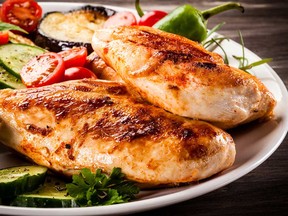People may think they’re reducing the likelihood of foodborne illness when they wash their poultry. In reality, they’re increasing the chances, says food safety expert

Reviews and recommendations are unbiased and products are independently selected. Postmedia may earn an affiliate commission from purchases made through links on this page.
Article content
Every so often, the question of whether or not you should wash raw poultry before cooking rears its head. Take TikToker Lehandra Staude (@lehandrabreanne), whom commenters criticized late last year for not cleaning her chicken before cooking. (She responded with a follow-up clip explaining why it’s a bad idea, according to Distractify). Or 2021’s notorious chicken wings washed with bleach and soap, which professors Ben Chapman and Don Schaffner deemed “risky” on their podcast, Risky or Not. A new study published in the forthcoming April issue of Food Control provides more evidence. It found that most people in eight Southeast Asian countries washed poultry at home, increasing the risk of cross-contamination with foodborne pathogens.
Advertisement 2
Article content
People may think they’re reducing the likelihood of foodborne illness when they wash their poultry. In reality, they’re increasing the chances, explains professor Lawrence Goodridge, director of the Canadian Research Institute for Food Safety at the University of Guelph, who was not involved in the study.
Article content
In various parts of the world, washing meat is a common practice because of perceptions of cleanliness. The Food Control study, for example, found that many people perceive poultry purchased from traditional markets as dirty, and the practice of washing it is entrenched in local cultures.
Goodridge recalls a comment raised by a student from an African country in class earlier this week. “(They) said, ‘In Africa, we tend to wash poultry because the harvest practices are not the same as what they are necessarily in America.’ There’s this perception that poultry is dirty. So, I think that’s the main reason why it keeps coming up over the years.”
He adds that people in Canada might have cultural reasons for washing poultry from countries they emigrated from. In North America, however, the manufacturing process eliminates any need to clean poultry of blood, feathers or other debris. “Certainly, in North America, there’s no need to wash poultry,” he says. “If there’s anything you want to remove from raw poultry, use a damp paper towel…. And that’s a damp paper towel with water — not bleach or soap or anything like that.”
Article content
Advertisement 3
Article content
Rinsing poultry under running water can generate aerosols, says Goodridge. If there are bacteria such as Salmonella or Campylobacter on the surface of the raw meat, those aerosols can carry it around the kitchen and deposit it on surfaces that come into contact with food, utensils and door handles. “That is how cross-contamination can happen. And, of course, if you’re preparing foods that are supposed to be eaten raw, like fresh fruits and vegetables, they can become cross-contaminated.”
Goodridge cites a 2019 study from the U.S. Department of Agriculture, which showed how easily bacteria can spread in home kitchens. Sixty per cent of people who washed their raw poultry had bacteria in their sinks after doing so. Perhaps even more concerning, 14 per cent still had bacteria in their sinks after they attempted to clean them and more than a quarter (26 per cent) contaminated their ready-to-eat salad with bacteria from their raw poultry.
The Food Control study found that salt was the preferred ingredient to wash raw poultry, which raises the question of brining, favoured by some cooks for juicier lean cuts. Bon Appétit and Allrecipes.com suggest rinsing or washing poultry after brining, a practice that Goodridge recommends against. He underscores that brining or soaking in vinegar might kill some bacteria but won’t kill all of them. “The best thing is not to rinse — just pat dry.”
Advertisement 4
Article content
Tips for reducing foodborne illness at home
“Most foodborne illnesses occur in the home kitchen because people don’t understand how to handle their foods,” says Goodridge. He offers the following tips to reduce the risk.
- Don’t thaw meat on the countertop. Instead, defrost it (in leak-proof packaging) in the sink filled with cold water or in the fridge.
- Put meat at the bottom of the fridge instead of the top so that if it’s thawing, the juices don’t drip onto other foods.
- Use separate plates and utensils for meat and fresh produce, and keep them clean.
- Wash your hands while handling and preparing raw meat and before touching other foods.
- Use a meat thermometer to ensure your cuts are adequately cooked.
“We always say there are four things people can do: cook, clean, separate and chill,” adds Goodridge. “The ‘separate’ is due to cross-contamination, so that’s where not rinsing poultry comes in.”
Recommended from Editorial
Our website is the place for the latest breaking news, exclusive scoops, longreads and provocative commentary. Please bookmark nationalpost.com and sign up for our cookbook and recipe newsletter, Cook This, here.
Article content





